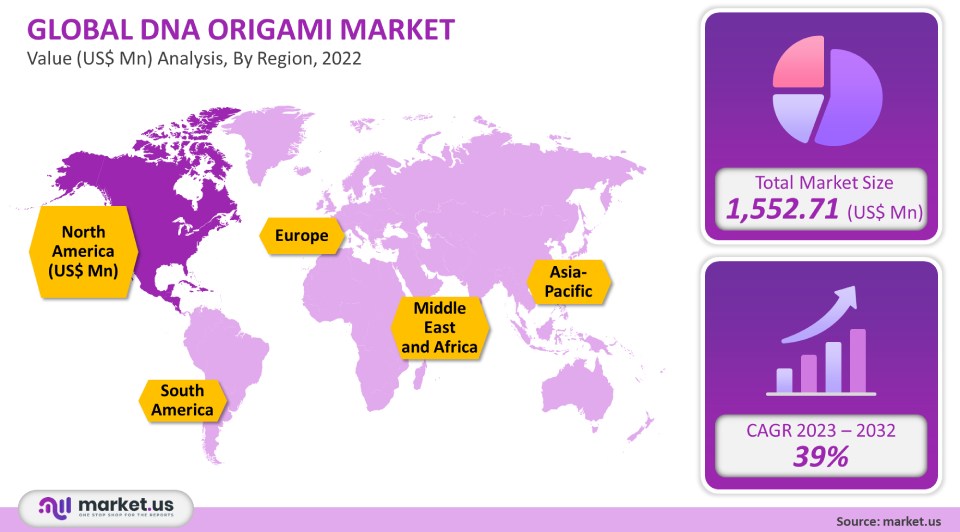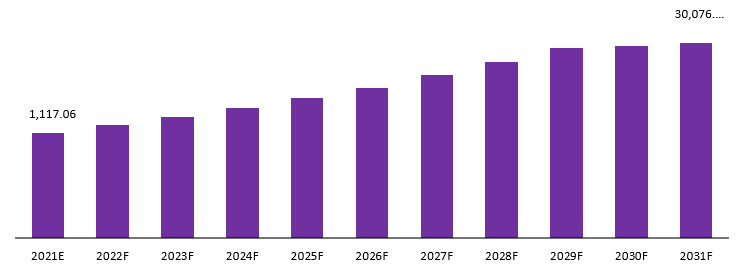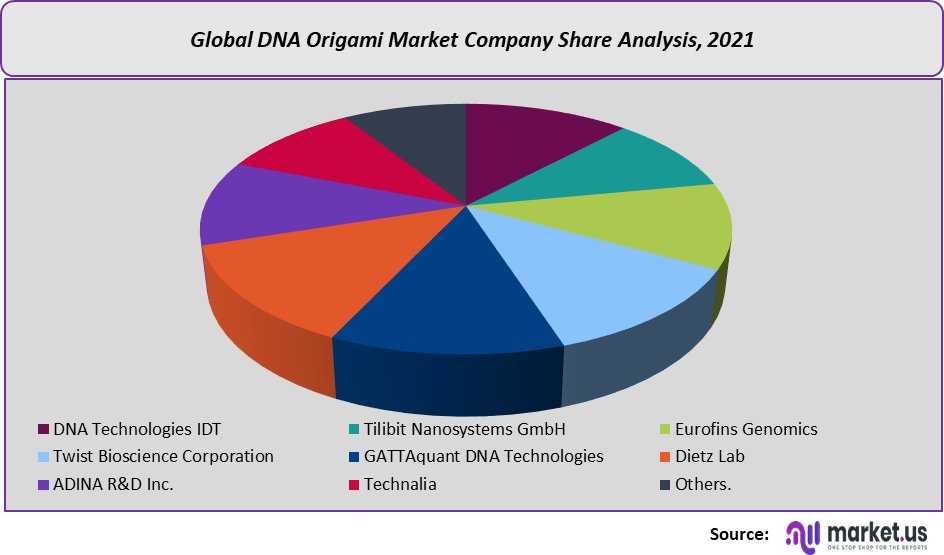Global DNA Origami Market, by Product Type (Single-stranded Scaffold DNA, Folding Kits, Staple Strand Oligos) by Structure (Static, Active), By Applications (Nanorobots & luorescence Studies, Enzyme-substrate Studies, Studies of Molecular Motors, Light, Energy) and by Region and Companies - Industry Segment Outlook, Market Assessment, Competition Scenario, Trends and Forecast 2022-2032
- Published date: Feb 2022
- Report ID: 84817
- Number of Pages: 283
- Format:
- keyboard_arrow_up
DNA Origami Market Overview:
The global DNA origami market is projected to reach a valuation of USD 41,806.07 Mn by 2032 at a CAGR of 39%, from USD 1,552.71 Mn in 2022.
DNA Origami is an innovative new branch of nanotechnology that is being used to create tiny, self-assembling structures out of DNA. A team of researchers led by Nadrian Seeman at New York University has created the first-ever working version of this technology. The process begins with a simple procedure known as “staple pulling”, where strands of DNA are folded up and held together using short actin protein strands known as “staples”. DNA origami has been used to create shapes that were previously difficult or impossible to make using conventional methods, such as 3D printing. DNA origami is a nanotechnology that is considered to be the newest and most exciting development in the field of biology. DNA origami has been used to create a device for transforming water and making it drinkable, and it can even be used to hack our cells and environment. The potential for this technology is immense, which is why if authorities don’t want to watch it fall into the wrong hands then they need to ensure that its progression is regulated carefully. DNA origami is a new technology that works by folding DNA to produce predetermined shapes. This technology will revolutionize the world of engineering.

DNA origami is a technique developed by scientists at the University of California, Los Angeles to manipulate DNA in order to create incredibly precise shapes out of DNA strands. It can be used to create complex shapes that are more intricate than those that are possible with traditional DNA manipulation techniques. This new technique has many potential uses, including designing more efficient solar cells and creating nanosensors to diagnose cancer.
DNA origami is an innovative new technology in which DNA strands are used to design 3D structures. Researchers at MIT have created a designer tool to make the process easier by using a simple program interface. The process starts with cutting the DNA strands, then folding them into shapes that are repeated until you have created your desired structure. Organizations are now using DNA origami to create new materials for use in fashion, medicine, and renewable energy. DNA origami is a technique that allows scientists to fold DNA into complex origami shapes. These shapes are then implanted with molecules that make the shape react chemically with its surroundings. Scientists can then measure these reactions to understand how natural processes work – biochemists have used this technique to study animal evolution and plant communication. There are many advantages to using DNA origami over traditional molecular construction methods. The construction of these devices can be inexpensive and it does not require any of the harmful chemicals typically used in chemical production processes.
Global DNA Origami Market Revenue (USD Mn), 2021–2031:

This market is primarily propelled by the increasing number of research & development activities, coupled with a greater demand for DNA-based technologies in the drug discovery and pharmaceutical sectors. Additionally, with surging demand for personalized medicine and improved healthcare insurance coverage for genetic testing, this market is expected to gain significantly, in terms of revenue.
DNA origami is much more efficient than other forms of medical research, is relatively inexpensive to produce, has no risk of contamination or side effects, and provides large quantities of material for study. Furthermore, the need for more efficient and cost-effective tools has never been greater. This is where DNA origami comes into play. Unlike other technologies, DNA origami can be produced cheaply without expensive equipment or electricity-based devices. This has resulted in an increasing number of companies switching to DNA origami over older, less efficient techniques. These are major factors that are anticipated to aid in augmenting this market in the years to come.The revolutionary technique of DNA origami takes genome engineering to new heights. In recent years, scientists have looked to develop new methods to investigate the fundamental mechanisms of life, but have been held back by the limitations of existing technologies. This has led to a market with few developments and ample opportunities for newcomers. One such company, CreaGenomics, is leading the charge in this field with its patented technology. These factors are expected to create lucrative opportunities for existing as well as emerging players in this industry.
The market for DNA origami has been growing exponentially since its inception in 2006. As these structures gain popularity, the market is expanding into biotechnology and pharmaceutical research. New methods of chain extension are being developed that will allow for longer 3D objects to be created by connecting shorter chains together. These innovations open up possibilities for new applications in nanomanufacturing and chemical synthesis. Ever wanted to have a life-sized teddy bear made of DNA? Well, now that’s a possibility, with the help of DNA origami. This new technique uses DNA strands to create shapes and designs. Its structure is made by folding long strands of DNA into itself, creating two-dimensional shapes for general display or 3D structures that are visible under an electron microscope.

This research report on the global DNA origami market includes major company profiles such as
- DNA Technologies IDT
- Tilibit Nanosystems GmbH
- Eurofins Genomics
- Twist Bioscience Corporation
- GATTAquant DNA Technologies
- Dietz Lab
- ADINA R&D Inc.
- Technalia
- Kosuri Lab
- Cees Dekkar Lab
- Others.
The Global DNA Origami Market Segmentation is Based on Product Types, Structure, Applications, and Region
Based on Product Types
- Single-Stranded Scaffold DNA
- Folding Kits
- Staple Strand Oligos
Based on Structure
- Static
- Active
Based on Applications
- Nanorobots & Luorescence Studies
- Enzyme-Substrate Studies
- Studies of Molecular Motors
- Light, Energy, & Microscopy Studies
- Dna Origami Drug Delivery
- Biosensors
- Other Applications
Based on Region
- North America
- Europe
- Asia-Pacific
- South America
- Middle East & Africa
For the DNA Origami Market research study, the following years have been considered to estimate the market size:
Attribute Report Details Historical Years
2016-2020
Base Year
2021
Estimated Year
2022
Short Term Projection Year
2028
Projected Year
2023
Long Term Projection Year
2032
Report Coverage
Competitive Landscape, Revenue analysis, Company Share Analysis, Manufacturers Analysis, Volume by Manufacturers, Key Segments, Key company analysis, Market Trends, Distribution Channel, Market Dynamics, COVID-19 Impact Analysis, strategy for existing players to grab maximum market share, and more.
Regional Scope
North America, Europe, Asia-Pacific, South America, Middle East & Africa
Country Scope
United States, Canada and Mexico, Germany, France, UK, Russia and Italy, China, Japan, Korea, India and Southeast Asia, Brazil, Argentina, Colombia etc.Saudi Arabia, UAE, Egypt, Nigeria and South Africa
![DNA Origami Маrkеt DNA Origami Маrkеt]()
- DNA Technologies IDT
- Tilibit Nanosystems GmbH
- Eurofins Genomics
- Twist Bioscience Corporation
- GATTAquant DNA Technologies
- Dietz Lab
- ADINA R&D Inc.
- Technalia
- Kosuri Lab
- Cees Dekkar Lab
- Others.
- settingsSettings
Our Clients
|
Single User
$5,999
$2,999
USD / per unit
save 50% |
Multi User
$7,999
$3,499
USD / per unit
save 55% |
Corporate User
$12,999
$4,499
USD / per unit
save 65% | |
|---|---|---|---|
| e-Access | |||
| Data Set (Excel) | |||
| Company Profile Library Access | |||
| Interactive Dashboard | |||
| Free Custumization | No | up to 10 hrs work | up to 30 hrs work |
| Accessibility | 1 User | 2-5 User | Unlimited |
| Analyst Support | up to 20 hrs | up to 40 hrs | up to 50 hrs |
| Benefit | Up to 20% off on next purchase | Up to 25% off on next purchase | Up to 30% off on next purchase |
| Buy Now ($ 2,999) | Buy Now ($ 3,499) | Buy Now ($ 4,499) |









